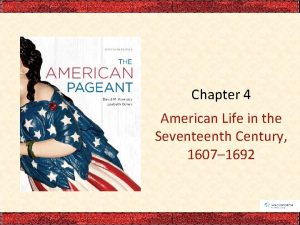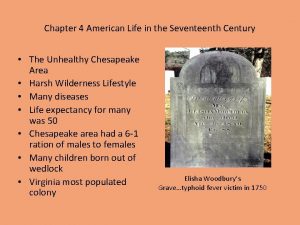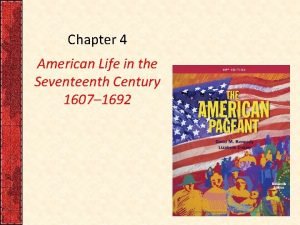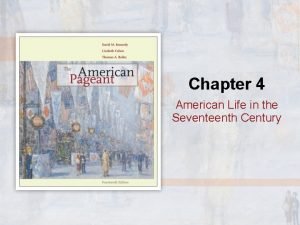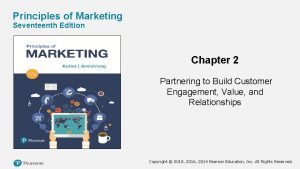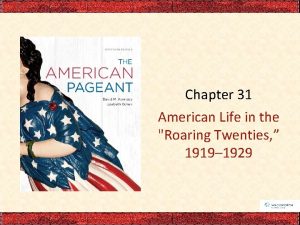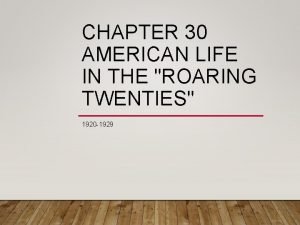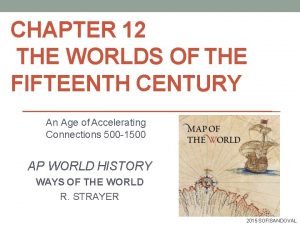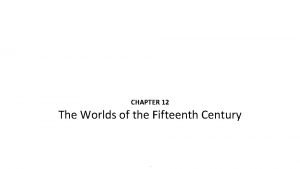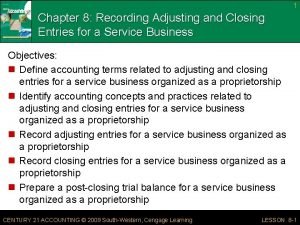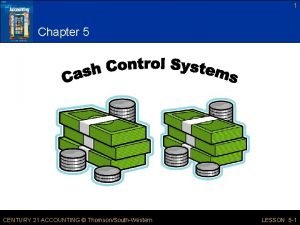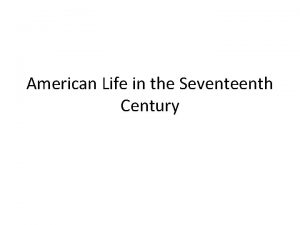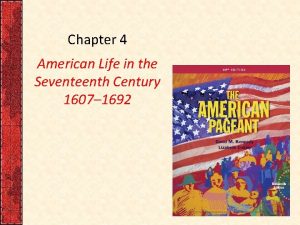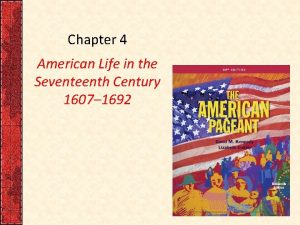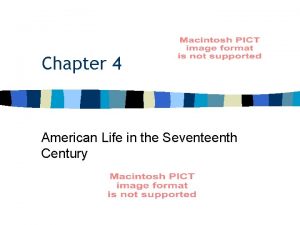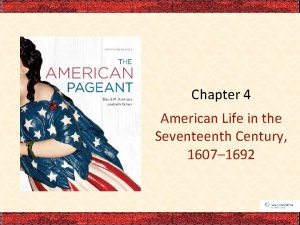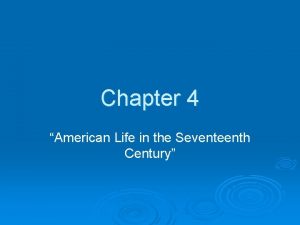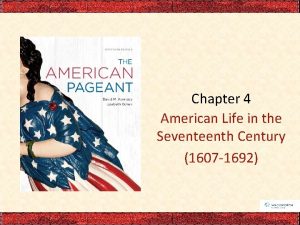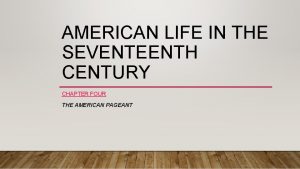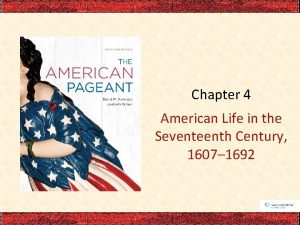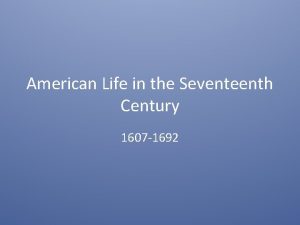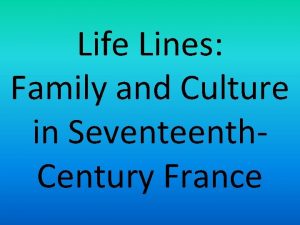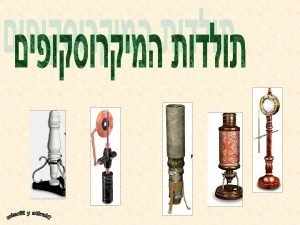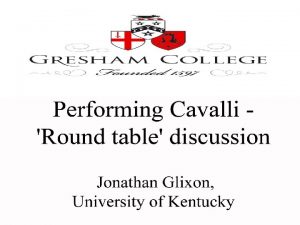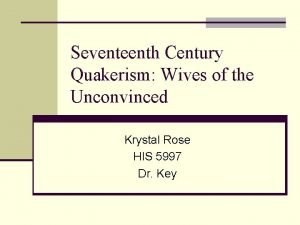Chapter 4 American Life in the Seventeenth Century



































- Slides: 35

Chapter 4 American Life in the Seventeenth Century

Unhealthy Chesapeake • Life for colonists was short and nasty. Malaria, dysentery and typhoid • ½ the people born in Viriginia and Maryland did not make it to 20 th birth day • Men outnumbered women 6 to 1 • Few and fragile families • Eventually, colony grew

Early Tobacco Advertising Crude woodcuts like this one were used to identify various “brands” of tobacco— one of the first products to be sold by brand name advertising.

Tobacco • Need for more land for tobacco created problems with Indians (expansion) • 1. 5 million pounds of tobacco taken out Chesapeake Bay by 1630 s • Need for labor: Where? • Families procreated slowly • Indians died too quickly • African slaves cost too much $$

Indentured Servitude • Europe had surplus workers—cloth industry, displaced farmers after English enclosed farms for grazing • Contract— 4 -7 years labor • They received: transatlantic passage and ax, hoe, corn, clothes and parcel of land

An Indentured Servant’s Contract, 1746

An Indentured Servant’s Contract, 1746

Headright System • Virginia and Maryland • For landowners---for every indentured servant = 50 acres of land • ****THIS HELPED CREATE THE HUGE PLANTATIONS SYSTEM/ LARGE ESTATES***** • More than 100, 000 brought to Virginia • Indentured Servants—led a hard life even after becoming free

Bacon’s Rebellion • Impoverished, single freemen (ex-indentured servants) in Cheasapeake • 1676— 1, 000 Virginians break out of control led by Nathaniel Bacon (many freemen) • Upset of attacks by Indians and Gov. William Berkely not retaliating • They attack capital—Berkeley responds by hanging 20 of them

Discontent • Large estates surrounded by discontents • Large plantations still needed laborers but were afraid of bringing more indentured servants • Solution? Africa

Colonial Slavery • After Columbus—More than 7 million African slaves brought • At first most went to Portuguese South America, West Indies (Caribbean) • At first slaves were too expensive for colonists • 1680’s this all changes—things get better in England (less people that would come here), large farmers fearful of ex-indentured servants

The Slave Ship Albatross, 1846 This eyewitness painting captures the dankness, gloom, and despair that reigned in the slaver’s cargo hold.

An African Slave Coffle Yoked and bound, these men, women, and children were on their way to a coastal slave market, where they would be herded aboard ship for the Americas.

Colonial Slavery • Slavery skyrockets—In some colonies African slaves outnumber whites • Middle passage—high death rates to get to America (20% died on the way) • Most from West Coast of Africa • Laws are changed to accomodate increasing African populations---African slaves are reclassified simply as PROPERTY. • Now a crime to teach slave to read or write • Slavery—first economic, then racial

The “Middle Passage” The “middle passage” referred to the transatlantic sea voyage that brought slaves to the New World—the long and hazardous “middle” segment of a journey that began with a forced march to the African coast and ended with a trek into the American interior.

Main Sources and Destinations of African Slaves, c. 1500 -1860 More than three centuries of the “African Diaspora” scattered blacks throughout the New World. Britain’s North American colonies (the future United States) constituted the extreme northern periphery of this system, receiving about 400, 000 of the nearly ten million arrivals, the great majority of whom ended up in the West Indies and Brazil.

Africans in America • Slavery—began due to economic reasons---race began to mold the slave system • South Carolina—rice fields were hells on earth for male Africans • Chesapeake—Tobacco fields less demanding crop, larger and closer to one another—more contact with friends/relatives • More females imported = slave families = ****NEW CULTURE CREATED**** African + American elements of speech, religion and folkways

Rice Cultivation in the Colonial South Rice growing, imported from Africa along with African slaves to work the swampy rice fields, made South Carolina the rice basket of the British Empire.

African Contributions to American culture • Jazz, bongo, banjo • Some slaves—skilled artisans, carpenters, bricklayers and tanners • Most worked on the fields

The Emergence of an African American Culture In this scene from the mid-nineteenth century, African Americans play musical instruments of European derivation, like the fiddle, as well as instruments of African origin, like the bones and banjo—a vivid illustration of the blending of the two cultures in the crucible of the New World.

Revolts • New York Slave Revolt— 1712—cost lives of 9 whites and caused execution of 21 blacks (burned at stake over slow fire). • South Carolina Slave Revolt— 1739—tried going to Florida, get stopped • Easier to control than indentured servants--Why?

Social Hierarchy in south • At top—small group of powerful planters, who owned many slaves, monopolizing political power and wealth. • Fitzhughs, Lees, Washingtons owned much of Virginia and controlled House of Burgesses • At the bottom—small farmers, had modest plots, owned one or two slaves. Below them were the indentured servants that were still serving their time • Southern life evolved solely around PLANTATIONS

A Merchant-Planter’s Home and Its Dining Room Simple by later standards, this house was home to the family of a substantial planter in the early eighteenth century. It stands on land in the Virginia tidewater region first acquired by Adam Thoroughgood, who arrived in the Virginia colony as an indentured servant in 1621. By 1635, as a freeman, he had recruited 105 settlers to the colony and was rewarded, according to the practice of the headright system, with the title to some 5, 250 acres along the Lynnhaven River. There his great-grandson erected this house in about 1720. It was continuously occupied by the Thoroughgood family for more than a century, until the 1860’s.

A Merchant-Planter’s Home and Its Dining Room Simple by later standards, this house was home to the family of a substantial planter in the early eighteenth century. It stands on land in the Virginia tidewater region first acquired by Adam Thoroughgood, who arrived in the Virginia colony as an indentured servant in 1621. By 1635, as a freeman, he had recruited 105 settlers to the colony and was rewarded, according to the practice of the headright system, with the title to some 5, 250 acres along the Lynnhaven River…

New England Family • New England colonists actually added 10 years to life expectancy • Life expectancy=70 years • Family—the center of N. E. life • Women—Child bearers • Not unusual for women to have up to 27 children • Nurturing environments—Family stability –low premarital pregnancies • Tranquil social structure

Women’s Rights • Southern women had separate property rights (men died young) • Northern women did not have separate property rights • Women considered morally weaker (remember eve? ) • However, abuse was not accepted in N. E. society • Divorce was rare in N. E. , adulterers whipped in public, had to wear the letter A (remember the Scarlet Letter)

Mrs. Elizabeth Freake and Baby Mary This portrait of a Boston mother and child in about 1674 suggests the strong family ties that characterized early New England society.

N. E. Towns • Tightly knit society • Puritanism gave purpose • Orderly—unlike the South, with large plantations and owners only looking for their own interests • Towns carefully laid out—had meetinghouse, place of worship and town hall, surrounded by the houses of the town, families received parcels of land • Had elementary education • ½ of all adults could read or write • 1636—Harvard College is established in Massachusetts by Puritans • 1693—William & Marry established in Virginia

Town meetinghouses • Model for Democracy • Adult males in the town would meet to elect officials, appoint schoolmasters, and discuss things like road repairs.



Salem Witch Trials • The Jeremiad—preachers scold parishioners for their waning faith, less conversions • 1662 -Half Way Covenant is announced—partial membership given to sons/daughters of those not yet fully converted (only baptized) • Puritan churches eventually opened it up to everyone—to increase participation—diluting the church • Women were the majority in the church • 1692— 20 killed, 19 were hanged and one was pressed to death • Witch Trials were the result of this church membership “widening”

Matthew Hopkins’s Witch Finder Hopkins was a seventeenth-century English witch-hunter whose techniques included watching suspects to see if diabolical creatures, in the form of common animals, fed on the alleged witch’s blood. He also urged that suspected witches be bound hand foot and tossed in a pond. The innocent, he claimed, would sink (and often drown), while the guilty would fl oat to the surface. His methods brought death to hundreds of women, and children in eastern England in the 1640 s.

New England Way of Life • Stony soil, sermons, cold climate discouraged non-England immigrants to come to New England. • Timber, shipbuilding, fishing and commerce became important • Calvanism, soil, climate, self reliance— gave purpose to N. E. • Chosen people of God • Impacted all of the U. S.

Days and Ways • Women—wove, cooked, cleaned, cared for children. • Men—cleared land, fenced, planted and cropped it, cut firewood, butchered livestock • Equality and democracy were part of American colonies (at least for white people)
 Chapter 4 american life in the seventeenth century
Chapter 4 american life in the seventeenth century Chapter 4 american life in the seventeenth century
Chapter 4 american life in the seventeenth century Chapter 4 american life in the seventeenth century
Chapter 4 american life in the seventeenth century Chapter 4 american life in the seventeenth century
Chapter 4 american life in the seventeenth century Pry lawler
Pry lawler Chapter 2 principles of marketing
Chapter 2 principles of marketing Chapter 31 american life in the roaring twenties
Chapter 31 american life in the roaring twenties Chapter 30 american life in the roaring twenties
Chapter 30 american life in the roaring twenties Chapter 12 the worlds of the fifteenth century
Chapter 12 the worlds of the fifteenth century Chapter 12 the worlds of the fifteenth century
Chapter 12 the worlds of the fifteenth century Chapter 8 recording adjusting and closing entries
Chapter 8 recording adjusting and closing entries Century 21 accounting chapter 5 study guide answers
Century 21 accounting chapter 5 study guide answers Hát kết hợp bộ gõ cơ thể
Hát kết hợp bộ gõ cơ thể Lp html
Lp html Bổ thể
Bổ thể Tỉ lệ cơ thể trẻ em
Tỉ lệ cơ thể trẻ em Voi kéo gỗ như thế nào
Voi kéo gỗ như thế nào Chụp tư thế worms-breton
Chụp tư thế worms-breton Chúa sống lại
Chúa sống lại Các môn thể thao bắt đầu bằng tiếng đua
Các môn thể thao bắt đầu bằng tiếng đua Thế nào là hệ số cao nhất
Thế nào là hệ số cao nhất Các châu lục và đại dương trên thế giới
Các châu lục và đại dương trên thế giới Công thức tính thế năng
Công thức tính thế năng Trời xanh đây là của chúng ta thể thơ
Trời xanh đây là của chúng ta thể thơ Mật thư tọa độ 5x5
Mật thư tọa độ 5x5 101012 bằng
101012 bằng Phản ứng thế ankan
Phản ứng thế ankan Các châu lục và đại dương trên thế giới
Các châu lục và đại dương trên thế giới Thể thơ truyền thống
Thể thơ truyền thống Quá trình desamine hóa có thể tạo ra
Quá trình desamine hóa có thể tạo ra Một số thể thơ truyền thống
Một số thể thơ truyền thống Cái miệng nó xinh thế
Cái miệng nó xinh thế Vẽ hình chiếu vuông góc của vật thể sau
Vẽ hình chiếu vuông góc của vật thể sau Nguyên nhân của sự mỏi cơ sinh 8
Nguyên nhân của sự mỏi cơ sinh 8 đặc điểm cơ thể của người tối cổ
đặc điểm cơ thể của người tối cổ Thế nào là giọng cùng tên?
Thế nào là giọng cùng tên?
